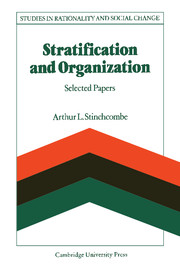Book contents
- Frontmatter
- Contents
- Acknowledgments
- 1 Rationality and social structure: an introduction
- PART I STRATIFICATION
- PART II ORGANIZATIONS
- PART III SOCIOLOGY AS A PROFESSION
- 13 On getting ‘hung-up’ and other assorted illnesses
- 14 Review of Max Weber's Economy and Society
- 15 Merton's theory of social structure
- 16 A structural analysis of sociology
- 17 On journal editing as a probabilistic process (Co-authored with Richard Ofshe)
- 18 The mathematical biology of survey research centres
- 19 Should sociologists forget their mothers and fathers?
- Bibliography
- Name and place-name index
- Subject index
18 - The mathematical biology of survey research centres
from PART III - SOCIOLOGY AS A PROFESSION
Published online by Cambridge University Press: 06 July 2010
- Frontmatter
- Contents
- Acknowledgments
- 1 Rationality and social structure: an introduction
- PART I STRATIFICATION
- PART II ORGANIZATIONS
- PART III SOCIOLOGY AS A PROFESSION
- 13 On getting ‘hung-up’ and other assorted illnesses
- 14 Review of Max Weber's Economy and Society
- 15 Merton's theory of social structure
- 16 A structural analysis of sociology
- 17 On journal editing as a probabilistic process (Co-authored with Richard Ofshe)
- 18 The mathematical biology of survey research centres
- 19 Should sociologists forget their mothers and fathers?
- Bibliography
- Name and place-name index
- Subject index
Summary
The hive or colony of social insects is divided into workers who go out to collect honey from the environment, and queens who eat disproportionate amounts of honey they did not collect, and produce eggs. The central question of hive viability is the ratio of queens to workers. The central question of species viability is whether enough new hives are created by new queens to replace hives that get destroyed by predators, that die out from too many queens and not enough workers, or that die out after the death of the queen keeps the workers from producing either workers or queens. It takes at least one queen to produce a hive.
In each of these respects the relations between researchers who write and professionals who do the work in survey research organizations is smiliar. It takes roughly one paid Ph.D. level professional worker to support sufficient data collection for a professor who uses survey research and his advanced students. The other analogies are obvious. Consequently the models that population biologists have worked out to study the growth of hives and species viability of social insects may be useful in analyzing the fate of survey research. In historical or participant observation or fact free research, each professor can be his own queen and his own worker, and hive viability is not a problem.
- Type
- Chapter
- Information
- Stratification and OrganizationSelected Papers, pp. 337 - 346Publisher: Cambridge University PressPrint publication year: 1986
- 1
- Cited by



